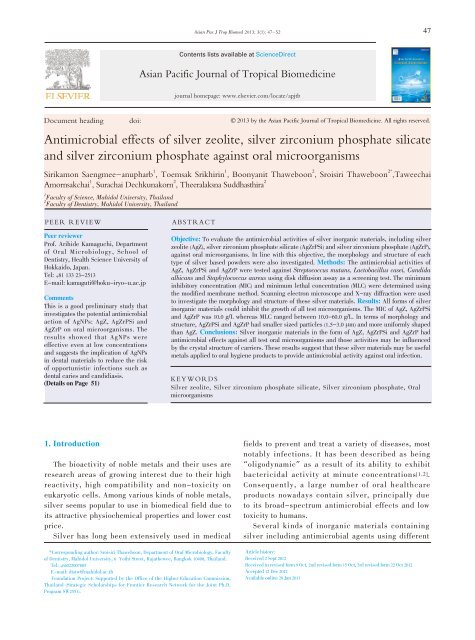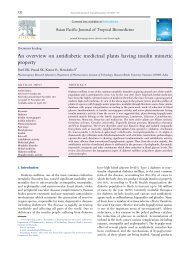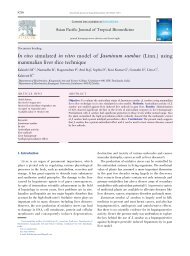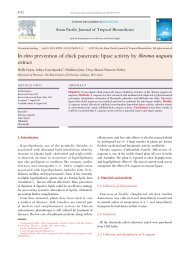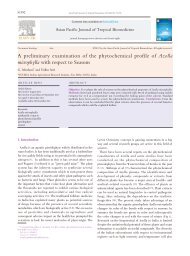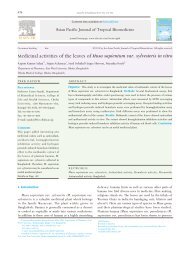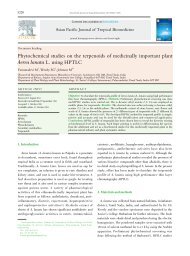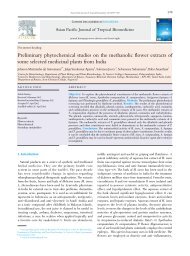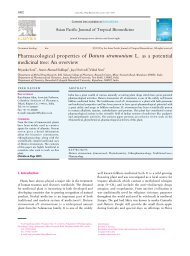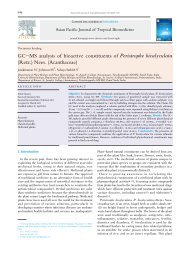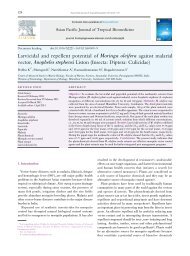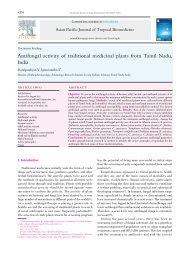Antimicrobial effects of silver zeolite, silver zirconium phosphate ...
Antimicrobial effects of silver zeolite, silver zirconium phosphate ...
Antimicrobial effects of silver zeolite, silver zirconium phosphate ...
You also want an ePaper? Increase the reach of your titles
YUMPU automatically turns print PDFs into web optimized ePapers that Google loves.
Asian Pac J Trop Biomed 2013; 3(1): 47-52<br />
47<br />
Contents lists available at ScienceDirect<br />
Asian Pacific Journal <strong>of</strong> Tropical Biomedicine<br />
journal homepage: www.elsevier.com/locate/apjtb<br />
Document heading doi: 襃 2013 by the Asian Pacific Journal <strong>of</strong> Tropical Biomedicine. All rights reserved.<br />
<strong>Antimicrobial</strong> <strong>effects</strong> <strong>of</strong> <strong>silver</strong> <strong>zeolite</strong>, <strong>silver</strong> <strong>zirconium</strong> <strong>phosphate</strong> silicate<br />
and <strong>silver</strong> <strong>zirconium</strong> <strong>phosphate</strong> against oral microorganisms<br />
Sirikamon Saengmee-anupharb 1 , Toemsak Srikhirin 1 , Boonyanit Thaweboon 2 , Sroisiri Thaweboon 2* ,Taweechai<br />
Amornsakchai 1 , Surachai Dechkunakorn 2 , Theeralaksna Suddhasthira 2<br />
1<br />
Faculty <strong>of</strong> Science, Mahidol University, Thailand<br />
2<br />
Faculty <strong>of</strong> Dentistry, Mahidol University, Thailand<br />
PEER REVIEW<br />
Peer reviewer<br />
Pr<strong>of</strong>. Arihide Kamaguchi, Department<br />
<strong>of</strong> Oral Microbiology, School <strong>of</strong><br />
Dentistry, Health Science University <strong>of</strong><br />
Hokkaido, Japan.<br />
Tel: +81 133 23-2513<br />
E-mail: kamaguti@hoku-iryo-u.ac.jp<br />
Comments<br />
This is a good preliminary study that<br />
investigates the potential antimicrobial<br />
action <strong>of</strong> AgNPs: AgZ, AgZrPSi and<br />
AgZrP on oral microorganisms. The<br />
results showed that AgNPs were<br />
effective even at low concentrations<br />
and suggests the implication <strong>of</strong> AgNPs<br />
in dental materials to reduce the risk<br />
<strong>of</strong> opportunistic infections such as<br />
dental caries and candidiasis.<br />
(Details on Page 51)<br />
ABSTRACT<br />
Objective: To evaluate the antimicrobial activities <strong>of</strong> <strong>silver</strong> inorganic materials, including <strong>silver</strong><br />
<strong>zeolite</strong> (AgZ), <strong>silver</strong> <strong>zirconium</strong> <strong>phosphate</strong> silicate (AgZrPSi) and <strong>silver</strong> <strong>zirconium</strong> <strong>phosphate</strong> (AgZrP),<br />
against oral microorganisms. In line with this objective, the morphology and structure <strong>of</strong> each<br />
type <strong>of</strong> <strong>silver</strong> based powders were also investigated. Methods: The antimicrobial activities <strong>of</strong><br />
AgZ, AgZrPSi and AgZrP were tested against Streptococcus mutans, Lactobacillus casei, Candida<br />
albicans and Staphylococcus aureus using disk diffusion assay as a screening test. The minimum<br />
inhibitory concentration (MIC) and minimum lethal concentration (MLC) were determined using<br />
the modified membrane method. Scanning electron microscope and X-ray diffraction were used<br />
to investigate the morphology and structure <strong>of</strong> these <strong>silver</strong> materials. Results: All forms <strong>of</strong> <strong>silver</strong><br />
inorganic materials could inhibit the growth <strong>of</strong> all test microorganisms. The MIC <strong>of</strong> AgZ, AgZrPSi<br />
and AgZrP was 10.0 g/L whereas MLC ranged between 10.0-60.0 g/L. In terms <strong>of</strong> morphology and<br />
structure, AgZrPSi and AgZrP had smaller sized particles (1.5-3.0 µm) and more uniformly shaped<br />
than AgZ. Conclusions: Silver inorganic materials in the form <strong>of</strong> AgZ, AgZrPSi and AgZrP had<br />
antimicrobial <strong>effects</strong> against all test oral microorganisms and those activities may be influenced<br />
by the crystal structure <strong>of</strong> carriers. These results suggest that these <strong>silver</strong> materials may be useful<br />
metals applied to oral hygiene products to provide antimicrobial activity against oral infection.<br />
KEYWORDS<br />
Silver <strong>zeolite</strong>, Silver <strong>zirconium</strong> <strong>phosphate</strong> silicate, Silver <strong>zirconium</strong> <strong>phosphate</strong>, Oral<br />
microorganisms<br />
1. Introduction<br />
The bioactivity <strong>of</strong> noble metals and their uses are<br />
research areas <strong>of</strong> growing interest due to their high<br />
reactivity, high compatibility and non-toxicity on<br />
eukaryotic cells. Among various kinds <strong>of</strong> noble metals,<br />
<strong>silver</strong> seems popular to use in biomedical field due to<br />
its attractive physiochemical properties and lower cost<br />
price.<br />
Silver has long been extensively used in medical<br />
*Corresponding author: Sroisiri Thaweboon, Department <strong>of</strong> Oral Microbiology, Faculty<br />
<strong>of</strong> Dentistry, Mahidol University, 6 Yothi Street, Rajathewee, Bangkok 10400, Thailand.<br />
Tel: +66022007805<br />
E-mail: dtstw@mahidol.ac.th<br />
Foundation Project: Supported by the Office <strong>of</strong> the Higher Education Commission,<br />
Thailand (Strategic Scholarships for Frontier Research Network for the Joint Ph.D.<br />
Program SW2551).<br />
fields to prevent and treat a variety <strong>of</strong> diseases, most<br />
notably infections. It has been described as being<br />
“oligodynamic” as a result <strong>of</strong> its ability to exhibit<br />
bactericidal activity at minute concentrations[1,2].<br />
Consequently, a large number <strong>of</strong> oral healthcare<br />
products nowadays contain <strong>silver</strong>, principally due<br />
to its broad-spectrum antimicrobial <strong>effects</strong> and low<br />
toxicity to humans.<br />
Several kinds <strong>of</strong> inorganic materials containing<br />
<strong>silver</strong> including antimicrobial agents using different<br />
Article history:<br />
Received 2 Sept 2012<br />
Received in revised form 9 Oct, 2nd revised form 15 Oct, 3rd revised form 22 Oct 2012<br />
Accepted 12 Dec 2012<br />
Available online 28 Jan 2013
48<br />
Sirikamon Saengmee-anupharb et al./Asian Pac J Trop Biomed 2013; 3(1): 47-52<br />
inorganic carriers such as <strong>zeolite</strong>, <strong>phosphate</strong>, titanium<br />
dioxide, activated carbon, montmorillonite, watersoluble<br />
glass and mesoporous silica, were developed<br />
to extend lifetime <strong>of</strong> <strong>silver</strong> . The prolonged constant<br />
dissociation <strong>of</strong> <strong>silver</strong> ions into the surrounding<br />
environment provides a higher clinical efficacy <strong>of</strong><br />
these <strong>silver</strong> containing materials. In addition, inorganic<br />
materials containing <strong>silver</strong> do not disturb the color <strong>of</strong><br />
the products[3,4].<br />
The antimicrobial activities <strong>of</strong> <strong>silver</strong> depend on the<br />
<strong>silver</strong> cation Ag + , which binds strongly to electron donor<br />
groups in biological molecules containing sulphur,<br />
oxygen or nitrogen. These <strong>silver</strong>-based materials<br />
have to release Ag +<br />
to a pathogenic environment to be<br />
effective.<br />
In dentistry, dental caries and candidiasis are<br />
common infections found in the oral cavity and create<br />
health problems for people in many countries. These<br />
conditions are caused by bacteria and yeast residing<br />
in the oral cavity. Dental caries is the destruction <strong>of</strong><br />
hard tissue <strong>of</strong> teeth due to acids produced by bacteria.<br />
Streptococcus mutans (S. mutans)and Lactobacillus spp.<br />
have been shown to have cariogenic potential owing<br />
to their acidogenic and aciduric abilities[5]. S. mutans<br />
appears to be important in the initiation <strong>of</strong> dental caries<br />
since its activities lead to colonization <strong>of</strong> the tooth<br />
surface, dental plaque formation and demineralization.<br />
Lactobacilli, mainly found in carious lesions, have been<br />
suspected to be secondary invaders that contribute to<br />
the progression <strong>of</strong> lesions. Apart from dental caries,<br />
oral candidiasis is a common opportunistic infection<br />
<strong>of</strong> the oral cavity caused by Candida spp. In the<br />
debilitated, compromised host, oral candidal infection<br />
may spread to the gastrointestinal tract, trachea, lungs,<br />
liver and central nervous system, capable <strong>of</strong> causing<br />
septicemia, meningitis and endocarditis[6-8]. The<br />
most frequent Candida spp. isolated from oral cavity<br />
is Candida. albicans (C. albicans) with the ability to<br />
adhere and colonize oral surfaces in large numbers[9].<br />
In addition, yeast cells can co-aggregate and make<br />
synergistic relationships with pathogenic bacteria such<br />
as Staphylococcus aureus (S. aureus) leading to a mixed<br />
infection. These include angular cheilitis, osteomyelitis<br />
<strong>of</strong> the jaw, parotitis and some endodontic infections[10].<br />
To our knowledge, no information exists regarding the<br />
comparison <strong>of</strong> antimicrobial activities <strong>of</strong> these different<br />
kinds <strong>of</strong> <strong>silver</strong> materials on the oral microorganism. The<br />
objective <strong>of</strong> this study was to evaluate the antimicrobial<br />
activity <strong>of</strong> <strong>silver</strong> inorganic materials, including <strong>silver</strong><br />
<strong>zeolite</strong> (AgZ), <strong>silver</strong> <strong>zirconium</strong> <strong>phosphate</strong> silicate<br />
(AgZrPSi) and <strong>silver</strong> <strong>zirconium</strong> <strong>phosphate</strong> (AgZrP),<br />
against oral microorganisms. The morphology and<br />
structure <strong>of</strong> each type <strong>of</strong> <strong>silver</strong>-based powder were also<br />
investigated.<br />
2. Materials and methods<br />
2.1. Silver based materials<br />
AgZ, AgZrP and AgZrPSi used in the present study<br />
contained 3 000 mg/kg <strong>silver</strong> ions. All test materials<br />
were supplied by the National Direct Network Company,<br />
Thailand and made into suspension in sterile distilled<br />
water at concentrations ranging from 1.0-20.0 g/L before<br />
testing.<br />
2.2. Materials characterization<br />
The original <strong>silver</strong>-based materials in powder form<br />
were used in the investigation. The morphology and<br />
crystal structure <strong>of</strong> the <strong>silver</strong>-based materials were<br />
characterized by scanning electron microscopy (SEM, 15<br />
kV, S-2500 Hitachi, Japan) and X-ray diffraction (XRD)<br />
technique (30 kV, 30 mA, Cu Kα, λ=0.15418 nm, Bruker<br />
D8 with Ni Kβ filtered), respectively.<br />
2.3. Microorganisms<br />
Oral microorganisms, S. mutans KPSK2, L. casei<br />
ATCC6363, C. albicans ATCC13803 and S. aureus ATCC<br />
5638, were obtained from the culture collection <strong>of</strong> the<br />
Department <strong>of</strong> Oral Microbiology, Faculty <strong>of</strong> Dentistry,<br />
Mahidol University, Thailand, They were maintained<br />
on brain heart infusion agar BBL, USA). Overnight<br />
cultures were prepared by inoculating approximately<br />
2 mL Mueller Hinton broth (Difco, USA) with 2-3<br />
colonies <strong>of</strong> each organism taken from BHI agar. Broth<br />
was incubated overnight at 37 °C for 48 h. Inocula were<br />
prepared by diluting cultures in saline solution to<br />
approximately 10 8 CFU/mL for bacteria and 10 7 CFU/<br />
mL for yeast. These suspensions were further used for<br />
antimicrobial tests.<br />
2.4. <strong>Antimicrobial</strong> activity<br />
2.4.1 Agar diffusion<br />
Agar cup diffusion method was employed to obtain<br />
the susceptibility pattern <strong>of</strong> microorganisms against<br />
each <strong>silver</strong>-based material. Briefly, 20 mL <strong>of</strong> Mueller<br />
Hinton agar was poured into a 80 mm-petri dish. The<br />
medium was allowed to cool and plates were then<br />
inoculated with 10 8 CFU/mL <strong>of</strong> bacteria or 10 7 CFU/mL<br />
<strong>of</strong> yeast. By punching the agar container with a sterile<br />
cork borer and scooping out the punched part, agar<br />
cups <strong>of</strong> 5 mm diameter were made.<br />
Each <strong>of</strong> the <strong>silver</strong> material suspensions (100 µL) at<br />
concentration <strong>of</strong> 10.0, 100.0 and 200.0 g/L was placed<br />
in each cup. Suspensions <strong>of</strong> carriers (<strong>zeolite</strong>, ZrP and<br />
ZrPSi) were used as controls. The plates were left to
Sirikamon Saengmee-anupharb et al./Asian Pac J Trop Biomed 2013; 3(1): 47-52<br />
49<br />
stay for an hour to facilitate the diffusion <strong>of</strong> the drug<br />
solution. Then the plates were incubated at 37 °C for 24<br />
h. The antimicrobial activity was evaluated based on<br />
zones <strong>of</strong> growth inhibition (mm).<br />
2.4.2. Minimum inhibitory concentration (MIC) and<br />
minimum lethal concentration (MLC)<br />
The MIC and MLC were determined using the<br />
membrane method described by Tantaoui-Elaraki et<br />
al[11]. Briefly, serial dilutions <strong>of</strong> <strong>silver</strong> material and<br />
carrier suspensions, ranging from 1.0 to 200.0 g/L were<br />
prepared in Mueller Hinton agar. Cellulose acetate<br />
membrane filters (0.45 µm porosity) (Sartorius, Germany)<br />
were placed on the surface <strong>of</strong> the agar plate and 25 µL<br />
<strong>of</strong> each microbial suspension (10 8 CFU/mL for bacteria<br />
and 10 7 CFU/mL for yeast) was dropped onto each filter.<br />
The plates were incubated at 37 °C for 24 to 48 h. The<br />
MIC values were determined as the lowest concentration<br />
<strong>of</strong> suspension inhibiting the visible growth <strong>of</strong> each<br />
organism on the membranes.<br />
For the determination <strong>of</strong> MLC, cellulose acetate filters<br />
without any microbial growth were transferred into<br />
brain heart infusion (BHI) broth and incubated at 37 °C<br />
for 72 h. The lowest concentration <strong>of</strong> <strong>silver</strong> materials or<br />
carriers showing no visible growth <strong>of</strong> the organisms in<br />
the tube was considered as the MLC. All the tests were<br />
performed in triplicate on three separate occasions.<br />
Using the agar cup diffusion method as a screening<br />
test, all <strong>of</strong> <strong>silver</strong> materials showed antimicrobial<br />
<strong>effects</strong> against all <strong>of</strong> test organisms with a zone <strong>of</strong><br />
inhibition ranging from 7 to 21 mm (Table 1). No<br />
growth inhibition was observed when exposed to the<br />
carriers without <strong>silver</strong> (<strong>zeolite</strong>, <strong>zirconium</strong> <strong>phosphate</strong><br />
silicate and <strong>zirconium</strong> <strong>phosphate</strong>). The MICs and MLCs<br />
<strong>of</strong> <strong>silver</strong> materials are shown in Table 2. All the test<br />
microorganisms were inhibited and killed at >10.0 g/L <strong>of</strong><br />
<strong>silver</strong> materials except for that <strong>of</strong> AgZ against S. aureus,<br />
which exhibited the MLC value <strong>of</strong> 60.0 g/L.<br />
Table 2<br />
MIC and MLC <strong>of</strong> <strong>silver</strong> inorganic materials against test ed<br />
microorganisms.<br />
Materials<br />
Concentration (g/L)<br />
S. mutans L. casei C. albicans S. aureus<br />
MIC MLC MIC MLC MIC MLC MIC MLC<br />
AgZ 10.0 10.0 10.0 10.0 10.0 10.0 10.0 60.0<br />
Ag ZrPSi 10.0 10.0 10.0 10.0 10.0 10.0 10.0 10.0<br />
AgZrP 10.0 10.0 10.0 10.0 10.0 10.0 10.0 10.0<br />
3. Results<br />
Table 1<br />
Inhibition zone <strong>of</strong> <strong>silver</strong> inorganic materials against test<br />
microorganisms.<br />
Concentration<br />
Zone <strong>of</strong> inhibition (mm)<br />
Materials<br />
(g/L)<br />
S. mutans L. casei C. albicans S. aureus<br />
1.0 AgZ - - - -<br />
Ag ZrPSi - - - -<br />
AgZrP - - - -<br />
Zeolite - - - -<br />
ZrPSi - - - -<br />
10.0 AgZ 10 7 7 11<br />
Ag ZrPSi 17 9 9 8<br />
AgZrP 21 10 8 14<br />
Zeolite - - - -<br />
ZrPSi - - - -<br />
100.0 AgZ 15 17 17 13<br />
Ag ZrPSi 11 15 14 11<br />
AgZrP 9 15 12 12<br />
Zeolite - - - -<br />
ZrPSi - - - -<br />
200.0 AgZ 14 16 18 14<br />
Ag ZrPSi 11 15 15 12<br />
AgZrP 10 17 14 13<br />
Zeolite - - - -<br />
ZrPSi - - - -<br />
AgZrP<br />
AgZrPSi<br />
AgZ<br />
14 12 10 8 6 4 2<br />
Figure 1. X-ray diffraction spectra <strong>of</strong> <strong>silver</strong> inorganic materials.<br />
AgZ shows 9 diffraction peaks consisting <strong>of</strong> D-spacing=12.278,<br />
8.672, 7.081, 5.488, 4.095, 3.708, 3.284, 2.983 and 2.622 Å. AgZrPSi<br />
presents 7 diffraction peaks <strong>of</strong> crystal structure (D-spacing=6.326,<br />
4.564, 4.396, 3.802, 3.165, 2.876 and 2.543 Å); the other 2 peaks<br />
(D-spacing=3.650 and 3.341 Å) are impure. For AgZrP, 7 diffraction<br />
peaks are observed including d-spacing=6.326, 4.552, 4.396, 3.810,<br />
3.165, 2.876 and 2.539 Å.<br />
D-spacing (Angstrom)
50<br />
Sirikamon Saengmee-anupharb et al./Asian Pac J Trop Biomed 2013; 3(1): 47-52<br />
The crystal structure <strong>of</strong> tested materials investigated<br />
Agz and Agzrpsi particles have bigger sizes compare<br />
with Agzrp particles by X-diffractometer is shown in<br />
Figure 1. The XRD patterns <strong>of</strong> AgZ showed 9 diffraction<br />
peaks which were consistent with the determined<br />
patterns <strong>of</strong> sodium aluminum silicate hydrate with<br />
cubic system. AgZrPSi presented 9 diffraction peaks;<br />
however only 7 peaks were confirmed as having the<br />
sodium <strong>zirconium</strong> <strong>phosphate</strong> silicate pattern <strong>of</strong> a<br />
rhombohedral system. The other 2 diffraction peaks<br />
were identified as impure which may be contaminated<br />
during the synthesis process. For AgZrP, 7 diffraction<br />
peaks were observed confirming the structure <strong>of</strong><br />
rhombohedral system. From the XRD data, it indicated<br />
that the structures <strong>of</strong> these <strong>silver</strong> inorganic materials<br />
and their carriers were almost identical. Small amount<br />
<strong>of</strong> <strong>silver</strong> ions adsorbed in the carriers did not change<br />
their crystal structures and no <strong>silver</strong> peak was found in<br />
the XRD patterns.<br />
4. Discussion<br />
The study demonstrated that <strong>silver</strong> inorganic<br />
materials including AgZ, AgZrPSi and AgZrP have<br />
antimicrobial <strong>effects</strong> on S. mutans, L. casei, C. albican<br />
and S. aureus. The MIC <strong>of</strong> AgZ, AgZrPSi and AgZrP was<br />
10.0 g/L whereas MLC ranged between 10.0-60.0 g/L.<br />
Several authors have reported that <strong>silver</strong> has a<br />
direct or indirect effect on microbial cells[12-15]. The<br />
antimicrobial activity exhibited by <strong>silver</strong> has resulted<br />
in the widespread use <strong>of</strong> <strong>silver</strong> particles in bedding,<br />
water purification, toothpastes, shampoos, fabrics,<br />
deodorants, filters, kitchen utensils and toys. Using<br />
<strong>silver</strong> in the form <strong>of</strong> small-sized particles shows<br />
efficient antimicrobial properties due to their extremely<br />
large surface area, producing an effective contact with<br />
microorganisms[15].<br />
Even though the precise mechanisms <strong>of</strong> biocidal<br />
activity <strong>of</strong> <strong>silver</strong> against microorganisms is not fully<br />
understood, the proposed antimicrobial mechanisms<br />
are first that, <strong>silver</strong> ions can associate with the cell<br />
wall [16], cell membrane[17], and cell envelope <strong>of</strong><br />
microorganisms[18,19]. The positive charge <strong>of</strong> a <strong>silver</strong><br />
ion is critical for antimicrobial activity, allowing<br />
electrostatic attraction between the negative charges<br />
<strong>of</strong> the bacterial cell membrane and positively charged<br />
<strong>silver</strong> particles causing cell membrane rupturing[17,20-<br />
22]. Low concentrations <strong>of</strong> <strong>silver</strong> ions were demonstrated<br />
to have the ability to induce a massive proton leakage<br />
through the bacterial membrane causing subsequent<br />
cell death[23,24].<br />
Second, <strong>silver</strong> ions can react with nucleophilic amino<br />
acid residues in proteins, attached to sulfhydryl, amino,<br />
imidazole, <strong>phosphate</strong> and carbonyl groups <strong>of</strong> membrane<br />
or enzyme proteins. A number <strong>of</strong> oxidative enzymes<br />
have been reported to be inhibited by <strong>silver</strong> ions such<br />
as yeast attached dehydrogenase, enzymes associated<br />
with the uptake <strong>of</strong> succinate by membrane vesicles and<br />
respiratory chains <strong>of</strong> bacteria. These resulted in the<br />
metabolites efflux, interfering with DNA replication,<br />
inactivation <strong>of</strong> ATP production and inhibition <strong>of</strong><br />
growth[16,22,25].<br />
Third, the antimicrobial action <strong>of</strong> <strong>silver</strong> particles is<br />
suggested to be related to the formation <strong>of</strong> free radicals<br />
and subsequent free radical-induced membrane<br />
damage[22]. As a result <strong>of</strong> the catalytic action <strong>of</strong> <strong>silver</strong><br />
ions, oxygen is changed into oxygen radicals by the<br />
action <strong>of</strong> light energy and/or H 2 O in the air or water<br />
only at polar surfaces and these oxygen radicals cause<br />
structural changes in microorganisms.<br />
In dentistry, with the aim to reduce bacterial and<br />
fungal adhesion to oral materials and devices, <strong>silver</strong><br />
particles have been developed and investigated<br />
for a range <strong>of</strong> possible applications, for example,<br />
incorporation into denture materials[26], dental<br />
implants[27], filling materials[28] and orthodontic<br />
adhesives[29]. However, little information is available<br />
regarding the antimicrobial <strong>effects</strong> <strong>of</strong> <strong>silver</strong> particles<br />
on oral species. Kawahara et al. evaluated the effect <strong>of</strong><br />
AgZ on a range <strong>of</strong> obligate and facultative anaerobic<br />
oral microorganisms [30]. It was found that gram<br />
negative species (Porphyromonas gingivalis, Prevotella<br />
intermedia and Aggregatibacter actinomycetemcomitans)<br />
were more susceptible than gram positive species<br />
(S. mutans, Streptococcus sanguinis, S. aureus and<br />
Actinomyces viscosus). It is speculated that the reduced<br />
amount <strong>of</strong> negatively charged peptidoglycans in the<br />
cell walls <strong>of</strong> gram negative species may account for<br />
the differences in susceptibility. In contrast, <strong>silver</strong>,<br />
in the form <strong>of</strong> titanium <strong>silver</strong> alloy, is <strong>of</strong>ten used as<br />
material for dental implants, orthodontic brackets,<br />
wires and screws, showing no inhibitory effect against<br />
Lactobacillus acidophilus[31]. With regard to oral yeast,<br />
<strong>silver</strong> particles have demonstrated a remarkable<br />
antifungal activity toward C. albicans by attacking the<br />
plasma membrane resulting in the formation <strong>of</strong> pores,<br />
disrupting the membrane potential, inhibiting the<br />
budding process, and causing subsequent cell death[32].<br />
Considering the antimicrobial activity and structure<br />
<strong>of</strong> the test materials, AgZrPSi and AgZrP showed higher<br />
antimicrobial ability than AgZ. It seems that crystal<br />
structure, the rhombohedral structure, not particle size,<br />
influenced the antimicrobial activity.<br />
In conclusion, <strong>silver</strong> inorganic materials in the<br />
form <strong>of</strong> AgZ, AgZrPSi and AgZrP had antimicrobial<br />
<strong>effects</strong> against all test oral microorganisms. The MIC<br />
<strong>of</strong> AgZ, AgZrPSi and AgZrP was 10.0 g/L whereas MLC
Sirikamon Saengmee-anupharb et al./Asian Pac J Trop Biomed 2013; 3(1): 47-52<br />
51<br />
ranged between 10.0-60.0 g/L. It is possible that the<br />
activities were influenced by the crystal structures and<br />
sizes <strong>of</strong> carriers. These <strong>silver</strong> particles may be useful<br />
materials applied to oral hygiene products to provide<br />
antimicrobial activities against oral infection. However,<br />
further studies are needed to evaluate the proper<br />
concentrations for final products and clinical studies.<br />
Conflict <strong>of</strong> interest statement<br />
We declare that we have no conflict <strong>of</strong> interest.<br />
Acknowledgements<br />
The authors would like to thank the Office <strong>of</strong> the<br />
Higher Education Commission, Thailand (Strategic<br />
Scholarships for Frontier Research Network for the<br />
Joint Ph.D. Program SW2551), Thailand Research Fund<br />
(TRF) and National Nanotechnology Center (NANOTEC)<br />
for their financial support.<br />
Comments<br />
Background<br />
Dental caries and oral candidiasis are the most<br />
commonly seen opportunistic infections in the oral<br />
cavity. Recently there has been a surge in interest on<br />
the use <strong>of</strong> <strong>silver</strong> nano-particles (AgNPs) for its potential<br />
antimicrobial properties. It is based on incorporating<br />
AgNPs within minute voids found in crystalline<br />
structures <strong>of</strong> <strong>zeolite</strong>s and inorganic carriers such as<br />
<strong>zirconium</strong> <strong>phosphate</strong> silicate and <strong>zirconium</strong> <strong>phosphate</strong>.<br />
Overtime these <strong>silver</strong> particles can get released or get<br />
dissociated into <strong>silver</strong> ions and exchanged with other<br />
cations in the environment. It has been postulated that<br />
upon release AgNPs and <strong>silver</strong> ions can come in contact<br />
with micro-organisms in the environment and cause<br />
suppression <strong>of</strong> their development. Various mechanisms<br />
have been purposed for antimicrobial action <strong>of</strong><br />
AgNPs such as reduction in the production <strong>of</strong> vital<br />
microbial enzymes, interruption <strong>of</strong> RNA replication<br />
and alterations in cell wall permeability. This study<br />
evaluates the antimicrobial action <strong>of</strong> AgNPs on<br />
pathogenic oral micro-organisms primarily responsible<br />
for dental caries and oral candidiasis.<br />
Research frontiers<br />
Studies are being formed for the application <strong>of</strong> AgNPs<br />
in the field <strong>of</strong> biotechnology and bioengineering.<br />
The benefits are most sought in incorporating its<br />
antimicrobial properties in medical equipments such as<br />
surgical instruments, catheters, and wound dressings<br />
to reduce the risk <strong>of</strong> infection. Research is also being<br />
conducted to incorporate AgNPs in dental materials<br />
such as cements, liners and polymethyl methacrylate<br />
for a sustained antimicrobial action.<br />
Related reports<br />
T h i s s t u d y c o n c l u d e d t h a t t h e A g N P s h a d<br />
antimicrobial action against S. mutans, Lactobacillus<br />
casei, S. aureus and C. albicans at concentration <strong>of</strong><br />
MLC concentration <strong>of</strong> 10.0-60.0 g/L. However the study<br />
could not explain the exact mechanism <strong>of</strong> action <strong>of</strong><br />
AgNPs. Study by Xiu et al. (2012) have shown <strong>silver</strong> ions<br />
released from AgNPs had antimicrobial properties<br />
against Escherichia coli at concentrations <strong>of</strong> 120.0-<br />
310.0 g/L.<br />
Innovations and breakthroughs<br />
Data on the antimicrobial properties <strong>of</strong> AgNPs is<br />
limited. This study evaluates the minimum inhibitory<br />
concentration and minimum lethal concentration <strong>of</strong><br />
<strong>silver</strong> <strong>zeolite</strong>, <strong>silver</strong> <strong>zirconium</strong> <strong>phosphate</strong> silicate<br />
and <strong>silver</strong> <strong>zirconium</strong> <strong>phosphate</strong> against oral microorganisms.<br />
Furthermore this study also uses scanning<br />
electron microscope and X-ray diffusion to evaluate<br />
the structures <strong>of</strong> the <strong>silver</strong> particles.<br />
Applications<br />
It is beneficial to know the potential application <strong>of</strong><br />
AgNPs in dentistry. The result <strong>of</strong> the study has shown<br />
that AgNPs are effective against opportunistic oral<br />
microorganisms even at low concentrations. However<br />
future studies on the sustainability <strong>of</strong> ion release<br />
from these nano-particles, changes in the physical<br />
properties <strong>of</strong> the incorporated material and the toxicity<br />
related to the oral tissues are necessary to justify its<br />
clinical use.<br />
Peer review<br />
This is a good preliminary study that investigates<br />
the potential antimicrobial action <strong>of</strong> AgNPs: <strong>silver</strong><br />
<strong>zeolite</strong>, <strong>silver</strong> <strong>zirconium</strong> <strong>phosphate</strong> silicate and <strong>silver</strong><br />
<strong>zirconium</strong> <strong>phosphate</strong> on oral microorganisms. The<br />
results showed that AgNPs were effective even at low<br />
concentrations and suggests the implication <strong>of</strong> AgNPs<br />
in dental materials to reduce the risk <strong>of</strong> opportunistic<br />
infections such as dental caries and candidiasis.<br />
References<br />
[1] Sintubin L, Verstraete W, Boon N. Biologically produced<br />
nano<strong>silver</strong>: current state and future perspectives.
52<br />
Sirikamon Saengmee-anupharb et al./Asian Pac J Trop Biomed 2013; 3(1): 47-52<br />
Biotechnol Bioeng 2012; 4. doi: 10.1002/bit.24570.<br />
[2] Collart D, Mehrabi S, Robinson L, Kepner B, Mintz EA.<br />
Efficacy <strong>of</strong> oligodynamic metals in the control <strong>of</strong> bacterial<br />
growth in humidifier water tanks and mist droplets. J Water<br />
Health 2006; 4: 149-156.<br />
[3] Sekhon BS, Kamboj SR. Inorganic nanomedicine-part 2.<br />
Nanomedicine 2010; 6: 612-618.<br />
[4] Sekhon BS, Kamboj SR. Inorganic nanomedicine-part 1.<br />
Nanomedicine 2010; 6: 516-522.<br />
[5] Parisotto T M, King W F, Duque C, Mattos-Graner<br />
RO, Steiner-Oliveira C, Nobre-Dos-Santos M, et al.<br />
Immunological and microbiologic changes during caries<br />
development in young children. Caries Res 2011; 45: 377-<br />
385.<br />
[6] Santos M, Thiene G, Sievers HH, Basso C. Candida<br />
endocarditis complicating transapical aortic valve<br />
implantation. Eur Heart J 2011; 32: 2265.<br />
[7] Ancalle IM, Rivera JA, García I, García L, Valcárcel M.<br />
Candida albicans meningitis and brain abscesses in a<br />
neonate: a case report. Bol Asoc Med P R 2010; 102: 45-48.<br />
[8] Badiee P, Alborzi A. Invasive fungal infections in renal<br />
transplant recipients. Exp Clin Transplant 2011; 9: 355-362.<br />
[9] Rautemaa R, Ramage G. Oral candidosis-clinical<br />
challenges <strong>of</strong> a bi<strong>of</strong>ilm disease. Crit Rev Microbiol 2011; 37:<br />
328-336.<br />
[10] Shirtliff ME, Peters BM, Jabra-Rizk MA. Cross-kingdom<br />
interactions: Candida albicans and bacteria. FEMS<br />
Microbiol Lett 2009; 299: 1-8.<br />
[11] Tantaoui-Elaraki A, Errifi A, Benjilali B, Lattaoui N.<br />
<strong>Antimicrobial</strong> activity <strong>of</strong> four chemically different essential<br />
oils. Rev Italiana 1992; 6: 13-22.<br />
[12] Percival SL, Thomas J, Linton S, Okel T, Corum L, Slone W.<br />
The antimicrobial efficacy <strong>of</strong> <strong>silver</strong> on antibiotic-resistant<br />
bacteria isolated from burn wounds. Int Wound J 2012; 9(5):<br />
488-493.<br />
[13] Song J, Kang H, Lee C, Hwang SH, Jang J. Aqueous<br />
synthesis <strong>of</strong> <strong>silver</strong> nanoparticle embedded cationic polymer<br />
nan<strong>of</strong>ibers and their antibacterial activity. ACS Appl Mater<br />
Interfaces 2011; Dec 28.<br />
[14] Lara HH, Garza-Treviño EN, Ixtepan-Turrent L, Singh DK.<br />
Silver nanoparticles are broad-spectrum bactericidal and<br />
virucidal compounds. J Nanobiotechnol 2011; 9: 30.<br />
[15] Chaloupka K, Malam Y, Seifalian AM. Nano<strong>silver</strong> as a new<br />
generation <strong>of</strong> nanoproduct in biomedical applications.<br />
Trends Biotechnol 2010; 28: 580-588.<br />
[16] Lara HH, Ayala-Nunez NV, Ixtepan-Turrent L, Rodriguez-<br />
Padilla C. Bactericidal effect <strong>of</strong> <strong>silver</strong> nanoparticles against<br />
multidrug-resistant bacteria. Wound J Microbiol Biotechnol<br />
2010; 26: 615-621.<br />
[17] Li WR, Xie XB, Shi QS, Zeng HY, Ou-Yang YS, Chen YB.<br />
Antibacterial activity and mechanism <strong>of</strong> <strong>silver</strong> nanoparticles<br />
on Escherichia coli. Appl Microbiol Biotechnol 2010; 85: 115-<br />
122.<br />
[18] Lara HH, Ayala-Nunez NV, Ixtepan-Turrent L, Rodriguez-<br />
Padilla C. Mode <strong>of</strong> antiviral action <strong>of</strong> <strong>silver</strong> nanoparticles<br />
against HIV-1. J Nanotechnology 2010; 8: 1.<br />
[19] Galdiero S, Falanga A, Vitiello M, Cantisani M, Marra V,<br />
Galdiero M. Silver nanoparticles as potential antiviral<br />
agents. Molecules 2011; 16: 8894-8918.<br />
[20] Sathishkumar M, Sneha K, Won SW, Cho CW, Kim S, Yun<br />
YS. Cinamon zeylanicum bark extract and powder mediated<br />
green synthesis <strong>of</strong> nanocrystalline <strong>silver</strong> particles and its<br />
bactericidal activity. Colloids Surf B Biointerfaces 2009; 73:<br />
332-338.<br />
[21] Barani H, Montazer M, Samadi N, Toliyat T. Nano <strong>silver</strong><br />
entrapped in phospholipids membrane: synthesis,<br />
characteristics and antibacterial kinetics. Mol Membr Bio<br />
2011; 28: 206-215.<br />
[22] Chen M, Yang Z, Wu H, Pan X, Xie X, Wu C. <strong>Antimicrobial</strong><br />
activity and the mechanism <strong>of</strong> <strong>silver</strong> nanoparticle<br />
thermosensitive gel. Int J Nanomecicine 2011; 6: 2873-2877.<br />
[23] Dastjerds R, Montazer M, Shahsavan S. A new method to<br />
stabilize nanoparticles on textile surfaces. Colloids Surf A<br />
Physiochemical Enginerr Aspects 2008; 317: 711-716.<br />
[24] Dastjerds R, Mojtahedi MR, Shoshtari AM, Khosroshahi A.<br />
Investigating the production and properties <strong>of</strong> Ag/TiO2/<br />
PP antibacterial nanocomposite filament yans. J Textile<br />
Institute 2010; 101: 204-213.<br />
[25] Li WR, Xie XB, Shi QS, Duan SS, Ouyang YS, Chen<br />
YB. Antibacterial effect <strong>of</strong> <strong>silver</strong> nanoparticles on<br />
Staphylococcus aureus. Biometals 2011; 24: 135-141.<br />
[26] Monteiro DR, Gorup LF, Takamiya AS, Ruvollo-Filho AL,<br />
de Camargo ER, Barbosa DB. The growing importance <strong>of</strong><br />
materials that prevent microbial adhesion: antimicrobial<br />
effect <strong>of</strong> medical devices containing <strong>silver</strong>. Int J Antimicrob<br />
Agents 2009; 34: 103-110.<br />
[27] Almaguer-Flores A, Ximenez-Fyvie LA, Rodil SE. Oral<br />
bacterial adhesion on amorphous carbon and titanium films:<br />
effect <strong>of</strong> surface roughness and culture media. J Biomed<br />
Mater Res B Appl Biomater 2010; 92: 196-204.<br />
[28] Cinar C, Ulusu T, Qzcelik B, Karamuftuoglu N, Yucel H.<br />
Antibacterial effect <strong>of</strong> <strong>silver</strong>-<strong>zeolite</strong> containing root-canal<br />
filling material. J Biomed Mater Res B Appl Biomater 2009;<br />
90: 592-595.<br />
[29] A h n S J , L e e S J , K o o k J K , L i m B S . E x p e r i m e n t a l<br />
antimicrobial orthodontic adhesives using nan<strong>of</strong>illers and<br />
<strong>silver</strong> nanoparticles. Dent Mater 2009; 25: 206-231.<br />
[30] K a w a h a r a K , T s u r u d a K , M o r i s h i t a M , U c h i d a M .<br />
Antibacterial effect <strong>of</strong> <strong>silver</strong>-<strong>zeolite</strong> on oral bacteria under<br />
anaerobic conditions. Dent Mater 2000; 16: 452-455.<br />
[31] Choi JY, Kim KH, Choy KC, Oh KT, Kim KN. Photocatalytic<br />
antibacterial effect <strong>of</strong> TiO 2 film formed on Ti and TiAg<br />
exposed to Lactobacillus acidophilus. J Biomed Mater Res B<br />
Appl Biomater 2007; 80: 353-359.<br />
[32] Kim KJ, Sung WS, Suh BK, Moon SK, Choi JS, Kim JG,<br />
et al. Antifungal activity and mode <strong>of</strong> action <strong>of</strong> <strong>silver</strong><br />
nanoparticles on Candida albicans. Biometals 2009; 22: 235-<br />
242.


